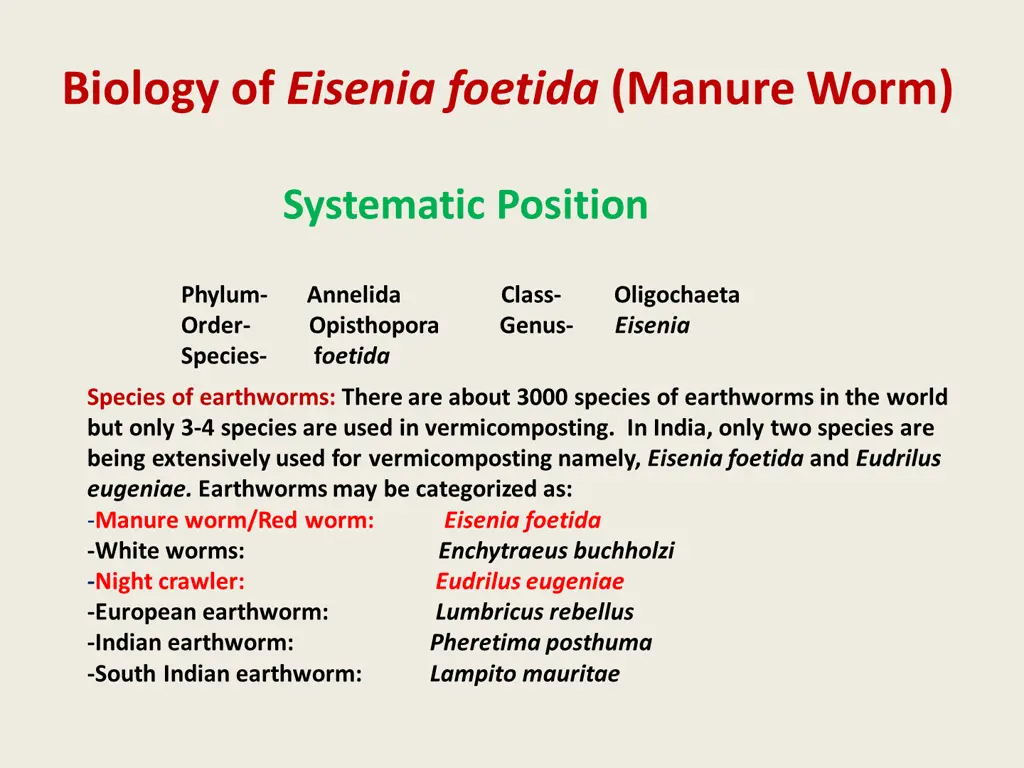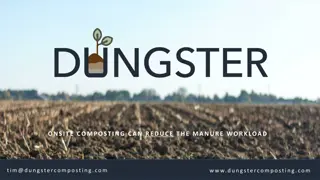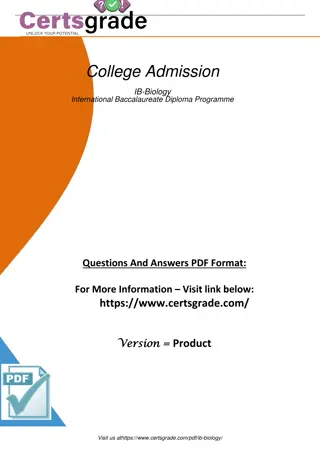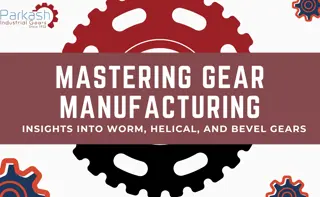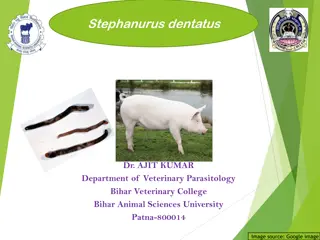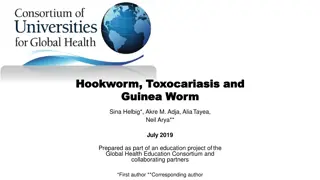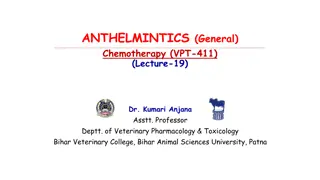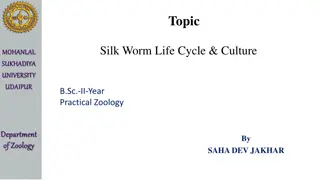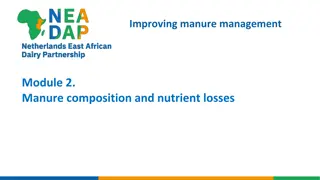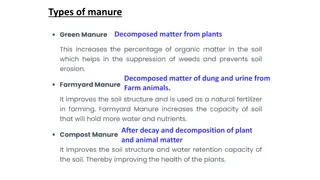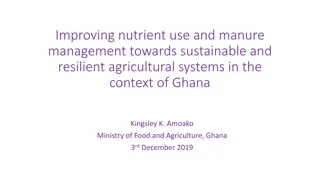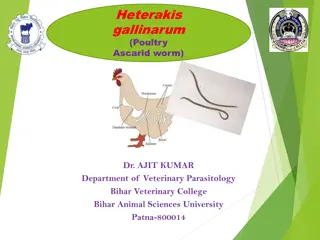Biology of Eisenia foetida (Manure Worm)
Learn about Eisenia foetida, a key earthworm species used in vermicomposting, its identification, ecology, efficiency, and morphology. Discover its burrowing habits, feeding behavior, reproduction capabilities, and environmental preferences for optimal performance in composting.
Download Presentation

Please find below an Image/Link to download the presentation.
The content on the website is provided AS IS for your information and personal use only. It may not be sold, licensed, or shared on other websites without obtaining consent from the author.If you encounter any issues during the download, it is possible that the publisher has removed the file from their server.
You are allowed to download the files provided on this website for personal or commercial use, subject to the condition that they are used lawfully. All files are the property of their respective owners.
The content on the website is provided AS IS for your information and personal use only. It may not be sold, licensed, or shared on other websites without obtaining consent from the author.
E N D
Presentation Transcript
Biology of Eisenia foetida (Manure Worm) Systematic Position Phylum- Annelida Class- Oligochaeta Order- Opisthopora Genus- Eisenia Species- foetida Species of earthworms: There are about 3000 species of earthworms in the world but only 3-4 species are used in vermicomposting. In India, only two species are being extensively used for vermicomposting namely, Eisenia foetida and Eudrilus eugeniae. Earthworms may be categorized as: -Manure worm/Red worm: Eisenia foetida -White worms: Enchytraeus buchholzi -Night crawler: Eudrilus eugeniae -European earthworm: Lumbricus rebellus -Indian earthworm: Pheretima posthuma -South Indian earthworm: Lampito mauritae
Important Species of Earthworms Lumbricus rebellus Eisenia foetida Eudrilus eugeniae Pheretima posthuma Enchytraeus buchholzi
Identifying characters of Eisenia foetida It is commonly known as red/manure/wriggler worm, etc. It is about 3-4 inches long. It has alternating prominent bands of darker and lighter red. This colouration is lighter between the bands. It has a slightly flat bottom with the rest of the body being round. The tail is sometimes a lighter colour often with yellow tip. This colouration comes and goes depending upon what it is fed. It stays near surface.
Ecology of Eisenia foetida It is burrowing in nature. It makes burrow by its anterior pointed end and by swallowing moist soil with sucking action of pharynx. It feeds on dead and decay organic matter present in the soil. Undigested food is egested out as worm castings or vermicompost. It is photonegative and geopositive. It requires 20-30 C temperature, 12-30 % moisture, 6.5 pH and well aerated soil for its efficient work. Life span is about 70 days. Growth is faster than other manure worms.
Efficiency of Eisenia foetida Most widely used earthworm in vermicomposting. It is quite hardy and can tolerate wide variation of temperature and humidity. It also survives on wide variety of degradable organic wastes. It grows and reproduce faster. It attains reproduction capability within 30-40 days. It can produce 2-3 cocoons /weak. Each cocoon hatches in 20-25 days and emerges 2-4 individuals, and number of individuals may increase up to 30 times. One adult can produce 250 worms. Cast production is about 4-7 mg/worm/day.
Morphology of Eisenia foetida a. Dorsal view b. Ventral view c. Peristomium and mouth
Shape and Size: Bisymmetrical, cylidrically elongated, about 15 cm long and 1.5 cm in width. Colour: Deep brown in colour due to porphyrin pigment which protects the body from bright sunlight. Segmentation: 100-120 metameres. Head: No distinct head, 1st segment is peristomium which bears terminal and crescentic mouth covered with a muscular flap, prostomium. Clitellum: Thick glandular band , surrounds 14th to 16th segments, secretes cocoon, divides body into three regions- pre-clitellar, clitellar and post-clitellar. Setae: Chitinous and S shaped locomotary organs, 80-120 setae present on mid ventral surface of each segment except peristomium, pygidium and clitellum. Apertures: These are mouth (1st seg.), anus (last seg.), spermathecal pores (ventro-lateral of 5/6, 6/7, 7/8 and 8/9 segments), female genital pore (mid-ventral of 14th seg.), male genital pores (one pair, ventro-lateral of 18th segment), nephridiopores scattered all over the body except first two segments and dorsal pores which are openings of coelomic chambers, situated on mid-dorsal intersegmental groove behind 12th segment. Genital Papillae: Two pairs, one pair each on ventro-lateral of 17th and 19th segment, provide grip during mating. Body wall: Thin covering, protects the body and secretes mucous, performs cutaneous respiration. Coelom: Septate eucoelom, filled with coelomic fluid which contains phagocytes, mucocytes, circular nucleated cells and chloragogen cells which protect the earthworm from pathogens.
Coelomic Fluid Composition: The fluid inside the coelom is known as coelomic fluid. It is generally secreted by the earthworms for maintaining moisture to help their physiological activities like respiration. It consists of watery matrix, the plasma and a large number of coelomocytes. These coelomocytes play a very important role in building innate immunity of earthworms, are differentiated into four different types of immune cells such as amoebocytes, mucocytes, circular cells and chloragogen cells, which have different shape, size and have wide variety of functions. It contains minerals like nitrogen, phosphorous, potassium, sodium, calcium, copper, iron, magnesium, manganese, zinc, etc. It also contains enzymes, hormones, vitamins, growth hormones, antibiotics, microflora, etc. Functions: The coelomic fluid serves several functions: it acts as a hydroskeleton. it allows free movement and growth of internal organs. it serves for transport of gases, nutrients and waste products between different parts of the body. it allows storage of sperm and eggs during maturation. It acts as a reservoir for waste.
Anatomy of Manure Worm Vital Systems and Activities: Digestive system: Ingests decay organic matters and egests undigested food as vermi castings. Circulatory system: Closed, Hb dissolved in plasma. Excretory system: Excretion by nephridia (Integumentary, pharyngeal & septal). Nervous system: Simple, consists of nerve ring and nerve cord. Sense organs: Tactoreceptors, photoreceptors and chemoreceptors (Gustatoreceptor and olfactoreceptor). Reproductive system and reproduction: Hermaphrodite, cross fertilization in cocoon due to protandrous condition, development direct, generally 2-3 young hatch out from cocoon. Locomotion: By setae. Respiration: By skin (Cutaneous respiration). Regeneration: It shows great power of regeneration if injured or cut.
Alimentary Canal It is straight and complete. It shows tube within a tube plan. It consists of following organs: Mouth and buccal cavity: Mouth is terminal and situated in 1stsegment peristomium and covered by prostomium. Mouth opens into buccal cavity which extends up to mid of 3rdsegment. Pharynx: Buccal cavity leads into pharynx which extends up to 4thsegment. It helps in swallowing of food and also secretes saliva which contains mucous and proteolytic enzymes. Oesophagus: It is a short and narrow tube which extends up to 7thsegment. It conducts the food. Gizzard: It is modified part of oesophagus. It is situated in 8thsegment. It is hard and muscular. It grinds the food. Stomach: Gizzard opens into a short and narrow tube; and with a valve at each end. It runs from 9thto 14thsegment. Calciferous glands of stomach secrete alkaline fluid which neutralizes the humic acid present in the soil.
Intestine: It is long and wide, extends from 15thto last segment. It is the chief site of digestion and absorption of food. It is divided into three regions: (1) Pre-typhlosolar region- from 15thto 26thsegment. (2) Typhlosolar region- from 27thto 23-25 segments from anus. It contains typhlosole which increases the absorption of digested food. (3) Post-typhlosolar region- It is rectum, situated in about 23-25 last segments. Anus: Alimentary canal opens out side by terminal and vertical anus, situated in the last segment pygidium. Feeding materials: It feeds on dead and decay organic materials which include: -Kitchen wastes -Garden wastes -Farmyard wastes -Crop residues -Dairy wastes -Industrial wastes, etc. What should not be fed to Earthworms : -Chemicals, plastics, metals, foils and glasses. -Oils, soaps, onion, garlic, citrus products, dog and cat manure. -spices, meat, bones and dairy products, etc.
Feeding Mechanism of Earthworm The peristomium encloses the mouth of the earthworm. It has no jaws or teeth. Food enters in the mouth. The pharynx acts as a suction pump; its muscular walls draw in food. Earthworm uses its muscular pharynx to suck in soil containing food. The food particles and soil go through a long esophagus into a very muscular organ called the gizzard. The gizzard contracts and expands, causing grains of sand and food to rub together. In this way, the food is ground up.
Reproductive System Earthworm is hermaphrodite (bisexual), hence it contains both male and female reproductive systems. (1) Male reproductive system: It includes following organs: Testes: 2 pairs, one pair each in 10th and 11th segment, ventro-lateral, attached to the testis sac, form sperms by spermatogenesis. Testis sacs: one pair, lobed, one each in 10th and 11th segment, enclose testes and spermiducal funnels, connected with seminal vesicles and separated from coelom. Seminal vesicles: 2 pairs, one pair each in 11th and 12th segment, mature and store the sperms. Spermiducal funnels: 2 pairs, one pair each in 10th and 11th segment, lead into Vasa deferentia. Vasa deferentia: 2 pairs, fine tubes, join the prostatic ducts. Prostate glands: One pair, extend from 16th or 17th segment to 20th or 21st segment, form common duct with sperm ducts and open into male genital pores. Accessory glands: 2 pairs, one pair each in 17th and 19th segment and open on genital papillae, secretion helps in mating.
(2) Female reproductive system: It includes following organs: Ovaries: One pair, situated in 13th segment, digitate, form ova by oogenesis which are arranged in linear fashion in various developing stages. Oviducal funnels: One pair, each situated just behind a ovary in 13th segment, receive ova, lead into oviducts. Oviducts: One pair, form common oviduct, opens into female genital pore in 14th segment. Spermathecae: 4 Pairs, flask shaped, ventro-lateral, one pair in each 6th, 7th, 8th and 9th segment, open in the groove of 5/6, 6/7, 7/8 and 8/9 segment. These receive and store the sperms from other worm during mating.
Mating Cocoon formation Hatching
Mating: Two worms apply to each other by their ventral surfaces with head ends pointing in opposite directions, so that the male genital pores of each lie against a pair of spermathecal pores of other. Now spermatic and prostatic fluids containing sperms are discharged into spermathecae. Cocoon formation: It is secreted by clitellum as girdle or band. It hardens on exposure to air and becomes tough and elastic cocoon or egg capsule. A slime tube is also secreted by clitellum over cocoon. As the worm wriggles behind, the slime tube and cocoon are slipped forward over the head. On its way , the cocoon receives ova from female genital aperture and sperms of other worm from spermathecae. Finally, when cocoon is thrown off the head, its elastic ends close up and a yellowish and rounded cocoon is formed. Many cocoons are formed in succession after each mating to utilize all stored sperms and ova. Fertilization: Fertilization takes place after the cocoon has been deposited in the moist soil. In each cocoon, many fertilized ova may be present. Development: Many zygotes are produced after fertilization but only 2-3 embryos develop. Other fertilized ova are degraded and serve as nurse cells to the growing embryos. Development is direct without any larval stage. Young worms when fully grown, crawl out of cocoon in about two or three weeks. Newly hatched young resemble the adult except for size and absence of clitellum. These do not receive the parental care.
Economic Importance As bait and food: -They are used as bait for fishing. -They form the best food for aquarium fishes and small laboratory animals (Enchytraeus buchholzi- White worm). -They are also consumed by uncivilized people. -They are hunted by birds, frogs, lizards, moles, centipedes, etc. In agriculture: -They continually plough and manure the soil, hence are friends of gardeners and farmers. In medicines: -They are used in medicines to treat the diseases like stones, jaundice, pyorrhoea, piles, gout, diarrhoea, weakness, etc. In laboratories: -They are universally used in class studies. Harmful worms: -They damage young and tender plants. -They cause water loss by seepage in agriculture fields. -They act as intermediate hosts of various parasites.
Importance of the Study of Biology of Manure Worm in: -Vermiculture -Vermicomposting -Vermiwash Preparation
Vermiculture and Vermicomposting Vermiculture: Breeding and raising of earthworms in controlled conditions. Vermicomposting: Making vermicompost by the use of earthworm. Preparation: Vermicomposting in Open heaps Pits Windrows (KISS plan) Bins Reactors Composition: It contains minerals like nitrate(ppm)- 902.2, phosphate(%)- 0.47, potassium(%)- 0.70, iron(ppm)- 7563.0, calcium(%)- 4.4, magnesium(%)- 0.46, zinc(ppm)- 278.0, etc., vitamins, antibiotics, growth hormones, enzymes, microflora, etc. Uses of Vermicompost: To prepare seed beds In flower pots In horticulture In agricultural crops In lawns, etc.
Preparation , Composition and Uses of Vermiwash Preparation: 1. Warm water method 3. Cold shock method Composition: Inorganic components: Nitrogen, phosphorous, Potassium, Sodium, Calcium, Copper, Ferrous, Magnesium, Manganese, Zinc, etc. Coelomocytes: Amoebocytes , Mucocytes, Circular cells and Chloragogen cells. 2. Electric shock method 4. Heat shock method Microbs: Heterotrophs, Nitrosomonas sp., Nitrobacter sp., fungi, etc. Others: Enzymes, hormones, vitamins, growth hormones, antibiotics,etc. Uses: Controls various plant diseases. A mixture of Vermiwash, cow urine and water acts as bio-pesticides and liquid manure. Increases the rate of photosynthesis, hence crop yield is increased. Increases the number of micro-organisms in soil. Increases the rate of decomposition of compost.
Thanks Thanks
